Spanish Legacy in Abilene
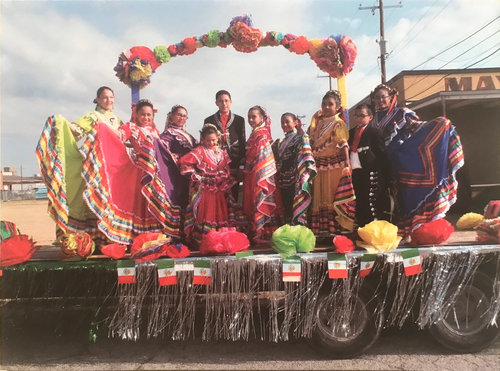
Spanish Legacy in Abilene
The growth of Mexicans/Mexican-Americans/Hispanics in Abilene, especially after the early 1900s, can be attributed to the need for workers to build the Texas & Pacific Railroad, migrant workers in the cotton fields and nearby farms, and construction and street workers for the growing town of Abilene. Many Hispanic families moved to California during the Dust Bowl and the Great Depression, however, many stayed and planted roots in a growing railroad town with various farms in proximity to help supply jobs with stability.
Today, Hispanics are a very important group in Abilene and contribute greatly to the community as business owners and educators, as professionals in the public and private sectors, and as active members in other arenas such as involvement in churches, volunteer and charitable organizations, and the arts.
El crecimiento en Abilene de la población mexicana/méxico-americana/hispanos especialmente después de 1900, puede ser atribuida a la necesidad de trabajadores para la construcción de las vías para el Ferrocarril de Tejas y el Pacífico, trabajadores emigrantes para los campos de algodón, granjas cercanas, y la construcción; y trabajadores para la creciente ciudad de Abilene. Muchas familias hispanas se mudaron a California durante el Dust Bowl y la Gran Depresión, sin embargo, muchos se quedaron y plantaron sus raíces en una creciente ciudad ferroviaria rodeada de granjas para suministrar puestos de trabajo y estabilidad.
Hoy en día, los hispanos forman un grupo importante en la comunicad de Abilene, y contribuyen bastante como dueños de negocios y educadores, como profesionales en los sectores públicos y privados, o como miembros activos en otras áreas como iglesias, organizaciones caritativas y en las artes.
Fiestas in the barrio
Fiestas in the barrio were held to either celebrate Mexico’s Independence in September, the ousting of the French on Cinco de Mayo, or religious holidays and feasts. The fiestas were a time to bring together people in the community through food, music, dance, and other fun activities.
In the present day, the Barrio de los Sancudos has been holding a reunion in July to bring together those that not only currently live in the community, but also those that have lived there in the past. The barrios are not as clear today due to individuals moving to other parts of the city and/or people that are not of Hispanic descent moving into the areas. The reunions help to retain that community bond and identity that might not necessarily be within the physical boundaries of the neighborhoods.
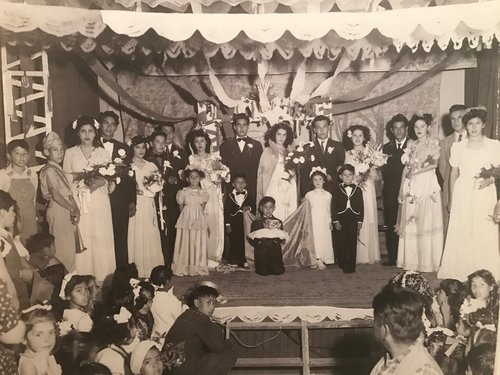
Las fiestas en el barrio se hacían para la celebración de la Independencia de México durante el mes de Septiembre, la expulsión de los franceses el cinco de mayo, o para los días festivos religiosos y banquetes. Las fiestas, que incluían comida, música, baile y otras actividades divertidas eran para que la gente de la comunidad se uniera.
Hoy día, el Barrio de los Sancudos todavía tiene reuniones en julio para reunir a esas personas que actualmente ya no viven en la comunidad, y también para los que vivieron allí en el pasado. Actualmente, los barrios no se pueden distinguir tan claramente debido a que varias personas se han mudado a otras partes de la cuidad y/o a personas que se han mudado al área y que no son descendientes de hispanos. Las reuniones ayudan a mantener los lazos e identidad de la comunidad que ya no estén dentro de los límites geográficos de los barrios.
Railroad Workers
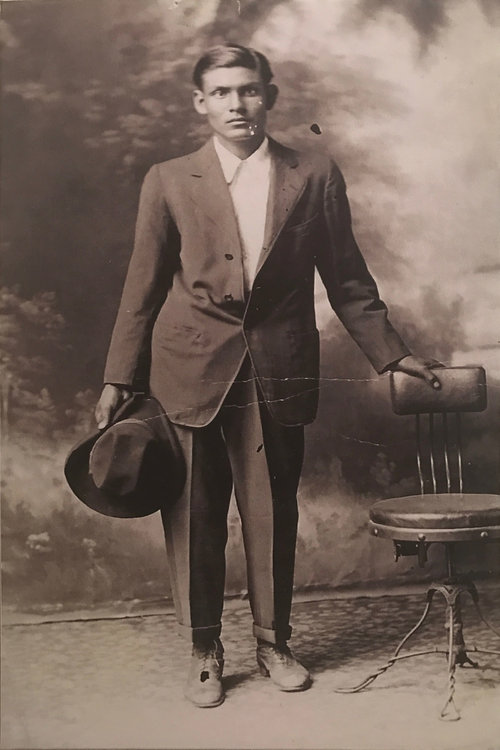
Hispanics that arrived to the Abilene area in the early 1880s, for the most part, came to work on the railroad. Luis Santibañez (1842-1927) was born in Mexico. As told by his grandson, longtime Abilene resident Fred Santibañez (1923-2011), Luis was captured by the French army and made to serve as a soldier. One night, while the French were distracted, Luis and another Mexican escaped. Luis was one of the first Texas & Pacific Railway (T&P) workers hired to complete sections of track in the Abilene area. The family lived in a T&P housing section in Baird. There were 20 sections in Baird because a railroad repair facility was located there. Fred’s father, Luis, was born in Baird and he worked for the T&P for 35 years. The Santibañez family settled in the Abilene area and are considered early Hispanic pioneers.
Los hispanos que llegaron a la región de Abilene a los principios de 1880, mayormente, llegaron a trabajar en el ferrocarril. Camilo Santibáñez (1842-1927) nació en México. Tal como lo cuenta su nieto, residente de Abilene por muchos años, Fred Santibáñez (1923-2011), Luis fue capturado por el ejército francés y fue obligado a enrolarse como soldado. Una noche, mientras los franceses estaban distraídos, Luis y otro mexicano se escaparon. Camilo fue uno de los primeros empleados Tejanos que completaron las secciones de los ferrocarriles en el área de Abilene. La familia vivió en una vivienda de T&P en la sección de Baird. Había 20 secciones en Baird porque el taller de reparación de los ferrocarriles de localizaba ahí. El padre de Fred fue nació en Baird y trabajó para T&P por 35 años. La familia Santibáñez se estableció en el área de Abilene y son considerados como los primeros pioneros hispanos.
Schools and Education
Text Courtesy of Mike P. Hernandez, Arroyo Catclaw Digital
Americanization schools popped up around the southwest and Texas in the early 1920s. The original idea was to create a platform for transition to American citizenship by teaching English and United States civic courses. Unfortunately, most of these schools instilled a sense of American superiority and pushed programs such as training for low-skilled work, personal hygiene, and American values. Catholic Schools also pushed an Americanization agenda to also enforce American values, culture, and morality. Students integrated into the Abilene school systems after the closure of the Sam Houston School in the late 1960s.
Las escuelas para la americanización surgieron alrededor del suroeste y Tejas a principios de 1920. La idea original era la creación de una plataforma de transición hacia la ciudadanía americana mediante la enseñanza del idioma inglés y cursos cívicos sobre los Estados Unidos. Desafortunadamente, la mayoría de estas escuelas inculcaron un sentido de superioridad americana e impulsaron programas como formación para el trabajo de mano de obra no-calificada, higiene personal, y valores americanos. Las escuelas católicas también impulsaron una agenda de americanización para implementar valores americanos, cultura, y moral. Los estudiantes se integraron en los sistemas escolares de Abilene después de la clausura de la escuela Sam Houston a finales de 1960.
Sam Houston Elementary was built on N. 6th and Cottonwood in 1949 to accommodate Mexican children, mainly for families that worked in the cotton fields. Their school year only lasted five months at the beginning to fit in with migrating families at the time, but extended to nine months as families settled in the area and went from a teacher of one to a six person staff. The school closed as a Mexican-American school in 1970 due to a failure to meet desegregation requirements. It now houses AISD’s Student Achievement Center.
La escuela primaria Sam Houston fue construida en la calle N. 6th y Cottonwood en el año 1949 para dar cabida a los niños mexicanos, principalmente para las familias que trabajaban en los campos de algodón. Al principio, su año escolar sólo duraba cinco meses para encajar con la migración de familias de esa época, pero después se extendió a nueve meses cuando las familias empezaron a establecerse en el área y el personal incremento de un maestro a seis. En el año, 1970 la escuela méxico-americana cerró debido a que no cumplía los requisitos de alto a la segregación. Ahora es la cede del centro de los logros estudiantiles AISD.
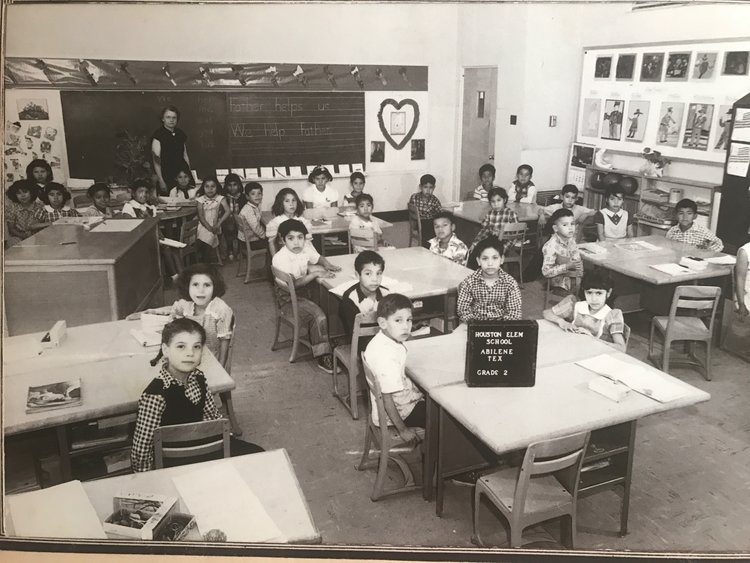
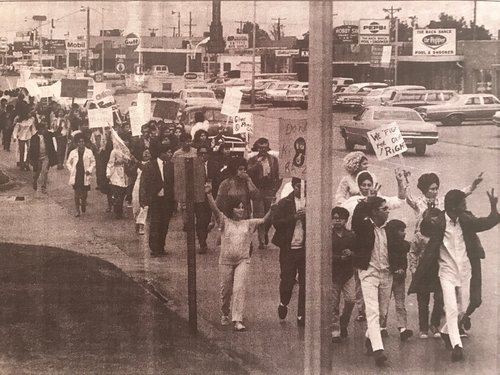
Similar to what was happening in other southwestern states and in other parts of Texas, Mexican-Americans/Hispanics/Chicanos’ awareness of injustices within schools spiked in the late 1960s in Abilene. In October of 1969, Hispanic students boycotted Abilene schools in protest of, mainly, not being able to speak Spanish in their schools. They had other demands as well, such as encouraging representation in student government, hiring more Mexican-American teachers and staff, and forming bilingual programs.
The boycott ended with the school board stating that there was no rule saying they could not speak Spanish at school, that they would try to hire more Mexican-American teachers, and that they would allow for Hispanic student organizations.
De forma similar a lo que estaba sucediendo en otros estados del suroeste y en otras partes de Tejas, la concientización de los méxico-americanos/hispanos/chicanos sobre las injusticiasen las escuelas, incremento a finales de 1960 en Abilene. En Octubre de 1969, los estudiantes hispanos boicotearon las escuelas de Abilene en protesta, principalmente por no poder hablar español en sus escuelas. También tenían otras demandas como representación en el gobierno estudiantil, la contratación de maestros(as) y trabajadores mexicoamericanos, y la creación de programas bilingües.
El boicot terminó cuando la mesa directiva de la escuela indicó que no había una regla que les impidiera hablar en español, que tratarían de contratar a más maestros(as) mexicoamericanos, y que permitían la creación de organizaciones estudiantiles hispanas.
The Catholic Church
The Catholic Church has been in Texas since the early sixteenth century, so there is no surprise that the first Catholic Church was erected shortly after the founding of Abilene. Sacred Heart Catholic Church, dedicated in 1893 and located on N. 5th and Beech, began offering services in Spanish in 1907, primarily for migrant workers that came during the cotton picking season. The current church, completed in 1931, was built in the Spanish colonial revival style with Moorish architectural elements.
St. Francis of Assisi Church first offered services in 1918 and was started as a missionary church for Mexican Catholics in the area. They were housed in the old Sacred Heart Church that was moved to N. 8th and Cottonwood. They also outgrew the building due to the population increase and a new church was dedicated in June of 1980.
Many Hispanics in Abilene have roots in the Catholic tradition, however, in modern times many Hispanics practice their Christian faith in other denominations. Many churches around the city and the Big Country offer services in Spanish and create the same type of community identity as the Catholic Church has done throughout many generations.
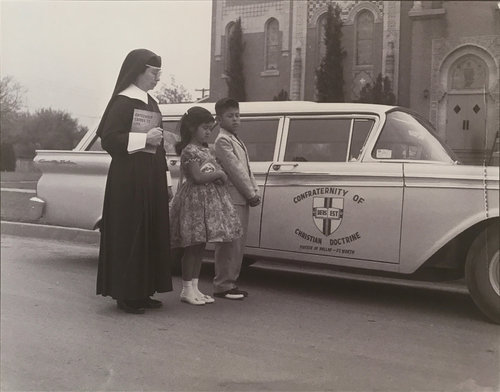
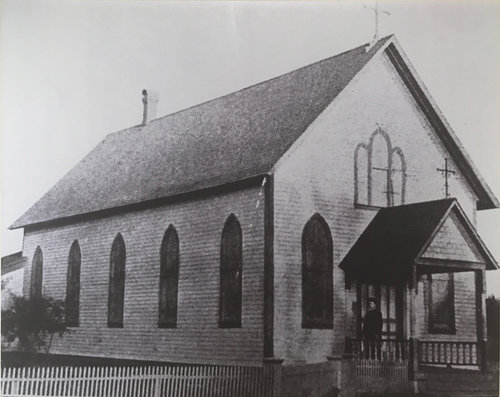
La iglesia católica ha estado en Tejas desde principios del siglo XVI, por eso no es de sorprenderse que la primera iglesia católica haya sido erigida un poco después de la fundación de Abilene. La iglesia católica Del Sagrado Corazón fue dedicada en 1893, y ubicada en N. 5 y Beech, empezó a ofrecer misas en español en 1907, especialmente para los trabajadores emigrantes que venían durante la estación de la pizca de algodón. La iglesia actual, se finalizó en el año 1931, fue construida al estilo español con elementos arquitectónicos árabes.
La iglesia San Francisco de Asís empezó a dar misa en 1918 y empezó como una iglesia misionaria para los mexicanos en el área. La iglesia se hospedó en la antigua iglesia del Sagrado Corazón para después ser restablecida en la calle N. 8 y Cottonwood. Debido al incremento de la población tuvieron que mudarse a una nueva iglesia en junio de 1980.
Muchos hispanos de Abilene, tienen una larga tradición católica, aunque, en la época moderna muchos de ellos continúan siendo cristianos bajo otras denominaciones. Varias Iglesias alrededor de la cuidad y del Gran Campo (Big Country) ofrecen servicios-misas en español y construyen el mismo tipo de identidad comunitaria, tal como las iglesias católicas lo han hecho durante varias generaciones.
Music and Culture
Spanish language radio emerged in Abilene in the early 1960s with the efforts of Manuel Hernandez. His hour on KWFA in Merkel and then KRBC AM radio in Abilene aired from 1978 to 1983. He also helped to promote local talents on cable channel 7 for many years. There have been several Spanish stations in Abilene throughout the years airing Tejano and traditional Spanish music. La Voz, which aired in Abilene in November 2012, brought a different type of radio station to the area because of the fact that it is locally owned, plays only Tejano music, and does broadcasts in English in attempts to appeal to the local people in Abilene.
Ballet Folklorico, derived from traditional folk dancing that includes religious topics, historical themes, and oral histories, was mainly modernized in the 1950s in Mexico City, and became popular in the United States in the 1960s. The dancers typically dance to Mariachi and/or Tejano music, whether live or recorded, in traditional clothing that includes a sombrero for the men and a full, colorful dress or skirt for the women. The dancers promote a sense of community and ability to share their heritage through the expressive form of dance.
Con los esfuerzos de Manuel Hernández, la radio en español surgió en Abilene a principios de 1960. Su hora en la estación KWFA en Merkel y luego en la estación de radio KRB AM en Abilene fue transmitida desde 1978 hasta 1983. El también, por varios años, ayudó a promover los talentos locales en el canal local 7. En Abilene, atreves de los años, han existido varias estaciones en español transmitiendo música Tejana y música tradicional en español. La Voz, empezó su transmisión en noviembre del 2012, esta es una estación de radio diferente porqueel propietarioo propietarios son de Abilene. Esta estación sólo presenta música Tejana y hace sus programas en inglés para atraer a las personas locales de Abilene.
El Ballet Folclórico, se derivó de bailes folclórico tradicionales que incluían temas religiosos, temas históricos, e historias orales, fue modernizado en 1950 en la ciudad de México, y se hizo popular en los Estados Unidos en 1960.

Los bailarines típicamente bailan música de mariachi o tejana, ya sea en vivo o grabado, el vestuario tradicional incluye un sombrero para los hombres y un vestido o falda lleno de colores para la mujer. Los bailarines promueven un sentido comunitario y comparten su herencia a través de la forma expresiva de la danza.
Tex-Mex
Tex-Mex or Mexican food in Texas can vary from region to region due to the availability of resources or proximity to other areas, such as more seafood based dishes along the coast. However, the Spanish influence and the mixture of indigenous crops in the area have created a unique culinary experience that Tejanos can call their own. The Spanish brought flour, beef, cheese, and garlic to mix with local foodstuffs such as chiles, corn, and squash. Thus, the evolution of Tex-Mex began early on since the arrival of the Spanish. With the growth of Mexicans/Hispanics into Abilene’s barrios in the early 20th century, several family-owned restaurants (and a few that are related to one another) have been sharing the mixture of Spanish and native traditions with the people of the region since the 1930s.
Fun fact – Fajitas are said to have their roots in Texas as skirt steak was used as compensation to the vaqueros on the ranches they worked on.
Christoval Herrera, a Mexican native who had come to Abilene in search of work in the mid-1920s, found a job as a dishwasher at the Windsor Hotel downtown. After working there for a few years, he opened the first Farolito Restaurant in 1936 off of Treadaway and E. Hwy 80. The original restaurant closed due to financial difficulties, but reopened in 1943 upon their return to Abilene in the original location. The restaurant, one of the oldest in Abilene, is still going strong and is owned and managed by Christoval and Barbara’s grandson Mark Hererra.
(Story derived from “Farolito’s Mexican Restaurant in Abilene began with dream 76 years ago”, Abilene Reporter News, September 1, 2012).
La comida Tex-Mex o comida mexicana de Tejas puede variar de región en base a la disponibilidad de recursos o a la proximidad de otras áreas, un ejemplo son los mariscos a lo largo de las costas marinas. Sin embargo, la influencia española y la mezcla de los cultivos indígenas en el área han creado una experiencia culinaria única que los Tejanos la consideran como suya. Los españoles trajeron la harina, carne, queso y ajo que se mezcló con la comida local como los chiles, maíz, y calabaza. De tal manera que la evolución de la comida Tex-Mex, e empezó con la llegada de los españoles. Con el incremento de mexicanos/hispanos en los barrios de Abilene en el siglo XX, varios restaurantes de familias locales han estado compartiendo, con las personas de la región, la mezcla de las tradiciones española e indígena desde 1930.
Hechos Divertidos– Se ha dicho que las fajitas han tenido raíces en Tejas como Filete en falda como una compensación a los vaqueros que trabajaban en los ranchos.